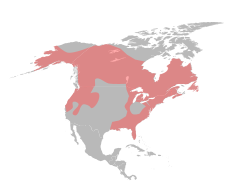북아메리카수달
북아메리카수달 또는 캐나다수달(Lontra canadensis)은 북아메리카 대륙에서 발견되며, 물가와 해안을 따라 서식하는 포유류의 일종이다.[2] 성숙한 북아메리카수달의 몸무게는 5.0~14kg 정도이다. 방수와 발수가 되는 두꺼운 모피를 통해 몸을 보호하고 단열을 한다.
|
| ||
|---|---|---|
 북아메리카수달 | ||
| 생물 분류ℹ️ | ||
| 계: | 동물계 | |
| 문: | 척삭동물문 | |
| 강: | 포유강 | |
| 목: | 식육목 | |
| 과: | 족제비과 | |
| 아과: | 수달아과 | |
| 속: | 아메리카수달속 | |
| 종: | 북아메리카수달 (L. canadensis) | |
| 학명 | ||
| Lontra canadensis | ||
| (Schreber, 1777) | ||
학명이명 | ||
|
Lutra canadensis | ||
| 아종 | ||
| ||
| 북아메리카수달의 분포 | ||
 북아메리카수달의 분포 지역 | ||
| 보전상태 | ||
|
| ||
족제비과 수달아과 아메리카수달속에 속하며 물 속과 땅 위 양쪽에서 생활이 가능하다. 강과 호수, 습지, 해변, 조석 평저 또는 강어귀 생태계의 물가 가까운 곳에 은신처를 만든다.
아종
편집7종의 아종이 알려져 있다.[3]
- L. c. canadensis (Schreber, 1777) – 캐나다 동부, 미국 뉴펀들랜드
- L. c. kodiacensis (Goldman, 1935) – 알래스카 코디악 제도
- L. c. lataxina (Cuvier, 1823) – 미국
- L. c. mira (Goldman, 1935) – 알래스카, 브리티시컬럼비아 주
- L. c. pacifica (J. A. Allen, 1898) – 알래스카, 캐나다, 미국 북부, 캘리오피나 남구와 중부, 네바다주 북부와 유타주 북동부
- L. c. periclyzomae (Elliot, 1905) – 브리티시컬럼비아 주
- L. c. sonora (Rhoads, 1898) – 미국, 멕시코
계통 분류
편집다음은 2018년 로(Law) 등의 연구에 기초한 수달아과의 계통 분류이다.[4]
| 수달아과 |
| ||||||||||||||||||||||||||||||||||||||||||||||||||||||||||||||||||
각주
편집- ↑ Serfass, T.; P. Polechla (2008). “Lontra canadensis”. 《2008 IUCN Red List of Threatened Species》. IUCN 2008. 2009년 1월 15일에 확인함.
- ↑ Koepfli, Klaus-Peter; Deere, K.A.; Slater, G.J.; Begg, C.; Begg, K.; Grassman, L.; Lucherini, M.; Veron, G.; Wayne, R.K. (February 2008). “Multigene phylogeny of the Mustelidae: Resolving relationships, tempo and biogeographic history of a mammalian adaptive radiation”. 《BMC Biology》 6: 10. doi:10.1186/1741-7007-6-10. PMC 2276185. PMID 18275614.
- ↑ Wilson, D.E.; Reeder, D.M., 편집. (2005). Mammal Species of the World: A Taxonomic and Geographic Reference (영어) 3판. 존스 홉킨스 대학교 출판사. ISBN 978-0-8018-8221-0. OCLC 62265494.
- ↑ Law, C. J.; Slater, G. J.; Mehta, R. S. (2018년 1월 1일). “Lineage Diversity and Size Disparity in Musteloidea: Testing Patterns of Adaptive Radiation Using Molecular and Fossil-Based Methods”. 《Systematic Biology》 67 (1): 127–144. doi:10.1093/sysbio/syx047. PMID 28472434.
